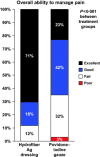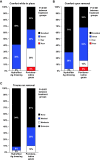Randomised clinical trial of Hydrofiber dressing with silver versus povidone-iodine gauze in the management of open surgical and traumatic wounds
- PMID: 17425549
- PMCID: PMC7951761
- DOI: 10.1111/j.1742-481X.2006.00276.x
Randomised clinical trial of Hydrofiber dressing with silver versus povidone-iodine gauze in the management of open surgical and traumatic wounds
Abstract
This prospective, randomised clinical trial compared pain, comfort, exudate management, wound healing and safety with Hydrofiber dressing with ionic silver (Hydrofiber Ag dressing) and with povidone-iodine gauze for the treatment of open surgical and traumatic wounds. Patients were treated with Hydrofiber Ag dressing or povidone-iodine gauze for up to 2 weeks. Pain severity was measured with a 10-cm visual analogue scale (VAS). Other parameters were assessed clinically with various scales. Pain VAS scores decreased during dressing removal in both groups, and decreased while the dressing was in place in the Hydrofiber Ag dressing group (n = 35) but not in the povidone-iodine gauze group (n = 32). Pain VAS scores were similar between treatment groups. At final evaluation, Hydrofiber Ag dressing was significantly better than povidone-iodine gauze for overall ability to manage pain (P < 0.001), overall comfort (P < or = 0.001), wound trauma on dressing removal (P = 0.001), exudate handling (P < 0.001) and ease of use (P < or = 0.001). Rates of complete healing at study completion were 23% for Hydrofiber Ag dressing and 9% for povidone-iodine gauze (P = ns). No adverse events were reported with Hydrofiber Ag dressing; one subject discontinued povidone-iodine gauze due to adverse skin reaction. Hydrofiber Ag dressing supported wound healing and reduced overall pain compared with povidone-iodine gauze in the treatment of open surgical wounds requiring an antimicrobial dressing.
Figures





References
-
- Pieper B, Templin TN, Dobal M, Jacox A. Wound prevalence, types, and treatments in home care. Adv Wound Care 1999;12:117–26. - PubMed
-
- Alvarez OM, Mertz PM, Eaglstein WH. The effect of occlusive dressings on collagen synthesis and re‐epithelialization in superficial wounds. J Surg Res 1983;35:142–8. - PubMed
-
- White RJ, Cutting KF. Interventions to avoid maceration of the skin and wound bed. Br J Nurs 2003;12:1186–201. - PubMed
-
- Lawrence JC. Dressings and wound infection. Am J Surg 1994;167:21S–4S. - PubMed
-
- Corazza M, Bulciolu G, Spisani L, Virgili A. Chemical burns following irritant contact with povidone‐iodine. Contact Dermatitis 1997;36:115–6. - PubMed
Publication types
MeSH terms
Substances
LinkOut - more resources
Full Text Sources
Medical
Miscellaneous

